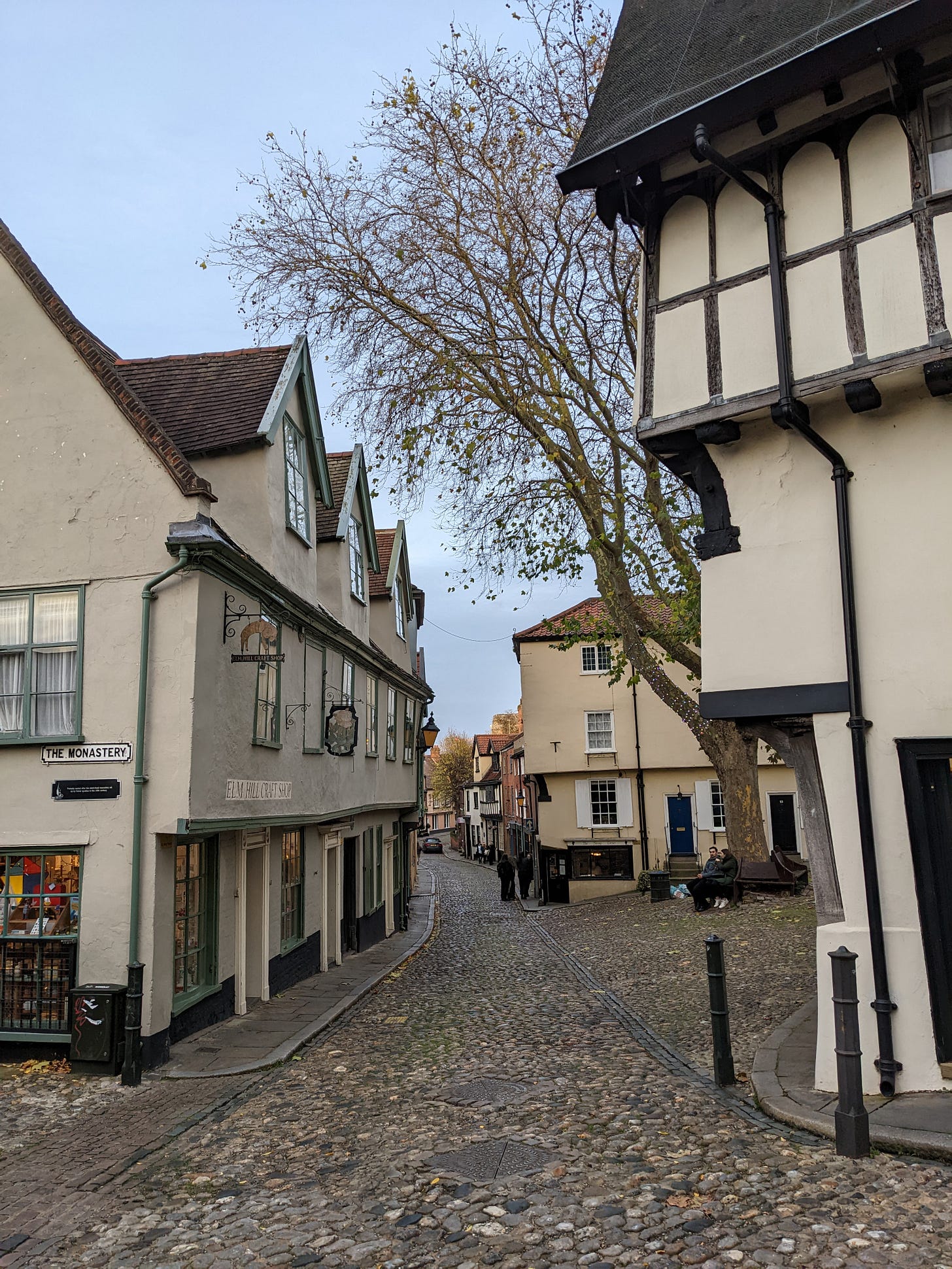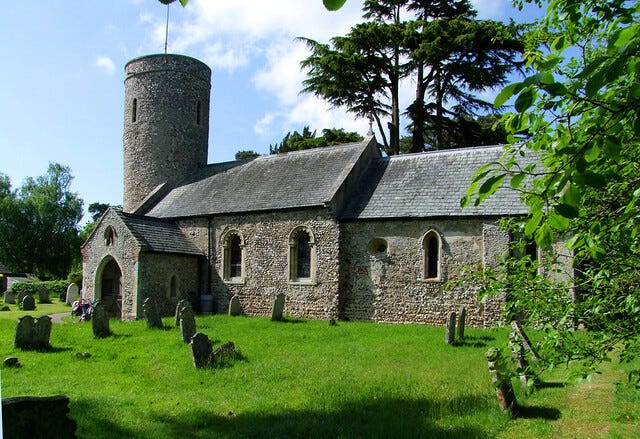Of Worms and Epitaphs: W.G. Sebald
In the first of our series exploring stories connected to the final resting places of significant cultural figures we visit W.G. Sebald's grave at St. Andrew's church in Norfolk.
Framingham Earl - a small, rather nondescript village a few miles south of Norwich – might seem like an unlikely resting place for one of the last great literary figures of the twentieth century. And yet it’s here, in a quiet churchyard just off the main road, that one can find the grave of W.G. Sebald, a man the late A.S Byatt described as, “one of the most important writers of our time”.
Sebald’s most famous works (such as The Rings of Saturn and Austerlitz) blend fiction, memory, history, biography, travelogue, and photography to create a unique hybrid genre quite unlike anything that had gone before it. Elegiac, melancholic, and haunted by the spectre of the holocaust and WWII, they are also infused with a dry sense of humour, resulting in a curious mixture that can only be described today as ‘Sebaldian’.
The Emigrants, the first of his books to be published in English, was acclaimed by Susan Sontag as “an astonishing masterpiece” when it appeared in 1996, and his stature as a literary figure, not to mention his influence on the broader cultural landscape, has continued to grow in subsequent years. Rachel Cusk, Will Self, Iain Sinclair and Tacita Dean (to name just a few) have cited Sebald as an inspiration, and he was considered a likely candidate for the Nobel Prize in literature before his tragic death in 2001, at the age of only 57, shortly after the publication of Austerlitz had brought him worldwide fame.
W. G. Sebald’s grave in St Andrew’s Church, Framingham Earl, image: Simon Knott
It may seem strange, then, that such a significant figure should be buried in this obscure corner of Norfolk instead of some famous cemetery in London surrounded by other literary giants. Highgate maybe, or Kensal Green. Framingham Earl, after all, is a fairly unremarkable place, consisting of little more than a long stretch of road lined with rather drab post-war houses and bungalows - the residential equivalent of a strip mall. Visitors will be hard-pressed to find much of interest beyond a couple of pubs and a fairly unconvincing American diner. But it was here that Sebald made his home, having bought and restored a nineteenth-century rectory in the neighbouring village of Poringland.
A new life in the heart of East Anglia
He first arrived in Norfolk in 1970, taking up a teaching position in the Centre for European Studies at the University of East Anglia (UEA) on the outskirts of Norwich. One of the “New Universities”of the 1960s, the neo-brutalist architecture of its campus and teaching buildings might seem like an odd environment for someone like Sebald, whose work was so rooted in history. But he would remain a vital part of the department for the next three decades, quickly settling into the department’s informal atmosphere and relishing the liberal, experimental and innovative climate of a university whose motto, “Do Different”, seems tailor-made for such a unique writer.
East Anglia also seemed to suit him, with its beautiful churches, picturesque villages and stately homes. In 1974 he even wrote an article about the region for the travel section of the German newspaper Die Zeit, describing Norwich, one of the most complete mediaeval cities in Britain, as a place where, “the presence of the past is immediately apparent”.
Elm Hill in Norwich, a city in which Sebald said “the presence of the past is immediately present.” Image: Cath Pound
Sebald lived for a time in the small market town of Wymondham, not far from the university. But in 1976 he and his wife Ute stumbled upon the Old Rectory in Poringland. It was an early Victorian red brick house in dire need of repair, with a large overgrown garden overlooking grounds belonging to the residence of the Roman Catholic Bishop of East Anglia. It was for sale and, due to its dilapidated state, they could actually afford to buy it on his lecturer’s salary.
A dream home in the English countryside
It seemed like the realisation of a dream – a perfect corner of the English countryside that he and his family could call their own – and, for a while at least, became the focus of their attention. Sebald took on extra translation work to pay for all the structural work needed to make the house habitable and, once they’d finally moved in, he and Ute spent another two years laying new floors, tiling the roof, taming the overgrown garden, and furnishing the rooms with pieces found at local auctions, which they carefully restored themselves. The neighbours knew him simply as Max (as he preferred to be known), many of them remaining unaware that he was such a famous writer until the reports of his death appeared in the local press.
As the years passed, the surrounding landscape of East Anglia would feed directly into Sebald’s most famous books, most obviously The Rings of Saturn. The book opens in the Norfolk and Norwich hospital and goes on to describe a walking tour of Suffolk which the narrator (ie; Sebald himself) had taken the previous year, beginning at Somerleyton Hall and progressing via Lowestoft, Southwold, Dunwich Heath, and Orford Ness. The flat featureless landscape, desolate locations, and grey oppressive sky are all described in vivid detail, accompanied by long, eloquent, and often drily witty digressions on history, literature, war, memory, and death. Elsewhere in the book, in a passage recounting the great storm which ravaged the UK in October 1987, Sebald is effectively describing the view from his own back garden at the Old Rectory.
Even the people he encountered during his years in East Anglia would resurface, subtly altered and re-named, in Sebald’s books. His neighbours from his early days in Wymondham become characters in the first chapter of The Emigrants, while one of his closest friends at UEA, the architectural historian Stefan Muthesius, would serve as the primary inspiration for the character Jacques Austerlitz in his final novel.
Over the past two decades, Sebald’s wanderings have inspired countless people to follow in his footsteps, recreating his trek along the Suffolk coast, which has become something of a modern, secular pilgrimage route. There’s even an acclaimed documentary, Patience: After Sebald (Grant Gee, 2012) which retraces his journey and includes contributions from friends and admirers such as Andrew Motion, Rick Moody and Marina Warner.
A tragic ending
Ultimately, Sebald would die not far from the place he had made his home. On 13th December 2001 he was driving his daughter into Norwich when he suffered a heart attack, losing control of the car and swerving into the path of a thirty-eight-ton truck. Neither the truck driver nor his daughter was seriously injured, but Sebald died instantly, possibly even before the impact.
St Andrew’s Church in Framingham Earl, image: Simon Knott
The funeral service was simple, as Sebald himself had requested. He was buried a few hundred metres from the Old Rectory, at St. Andrew’s, a small, picturesque church much like the ones the writer had celebrated in his article for Die Zeit so many years ago. A grade one listed building dating back to late-Saxon/early Norman times, it has a delightful round tower, ornate doorway, and some famous 15th Century stained-glass windows.
However, because of its isolated location, visitors are few and far between, and this charming little church is rarely open to the public. Most people who come these days do so to pay tribute to the famous writer buried there, perhaps leaving a small stone on top of the simple granite headstone that marks his grave, here in a quiet corner of the East Anglian countryside that inspired his most famous work.
Further Reading
Sebald’s most famous books, Vertigo (1990), The Emigrants (1992), The Rings of Saturn (1995), and Austerlitz (2001) are all readily available and unlikely to be going out print anytime soon.
After Nature (1988), an early book-length prose poem was eventually published in English in 2002, followed by a collection of his poetry, Across the Land and Water, in 2008.
For those who want to dig a little deeper, several collections of Sebald’s remarkable literary essays are also available, including A Place in the Country (1998), On the Natural History of Destruction (1999), and Campo Santo (2003).
Carole Angier’s Speak, Silence: In Search of W.G. Sebald (2021) is the most comprehensive English-language biography currently available, and a vital read for anyone who wants to get to grips with Sebald’s life and work.
Also recommended for anyone interested in getting a sense of Sebald’s voice outside of his published work, The Emergence of Memory: Conversations with W.G. Sebald (2011), edited by Lynne Sharon Schwartz is another essential read. It’s out of print at the moment, but second-hand copies aren’t that difficult to track down.
Beyond that, Sebald has inspired a mountain of academic analysis over the past twenty years - enough to fill a small bookshelf. But this is probably enough to be going with!








